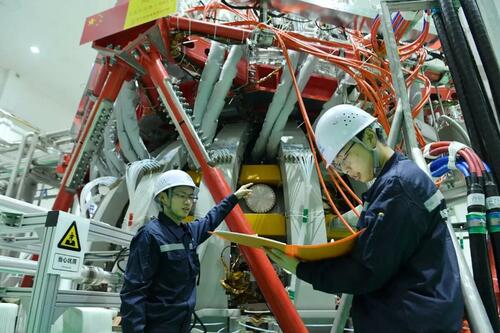
С Китаем, стремительно наращивающим ядерную энергетику, США столкнулись со «моментом спутника» ?
Автор John Haughey via The Epoch Times (выделено нами),
В США почти в два раза больше ядерных реакторов и, по крайней мере, в пять раз больше центров обработки данных, генерирующих искусственный интеллект, чем в Китае.
В этом столетии в США было построено всего две новые атомные электростанции. Китай построил почти 40 и, как сказал в мае заместитель председателя Управления по атомной энергии Китая Ван Ирен Китайской ассоциации ядерной энергетики, Коммунистическая партия Китая (КПК) «нацелена обогнать Соединенные Штаты по установленным ядерным мощностям к 2030 году. "
 Примерно половина центров обработки данных планеты находится в США. Томаш Рагина/Шуттерсток
Примерно половина центров обработки данных планеты находится в США. Томаш Рагина/ШуттерстокБыстрое развитие ядерной энергетики в Китае для питания искусственного интеллекта (ИИ) «спровоцировало момент Sputnik» среди разработчиков и операторов реакторов в США, сказал главный технический директор Oklo Пэт Швайгер.
"Лидерство ИИ — это вызов на уровне цивилизации, и мы сталкиваемся с геополитическим императивом для достижения превосходства ИИ.Швайгер сказал в своих показаниях во время слушания 12 июня в подкомитете по энергетике Комитета по науке, космосу и технологиям Палаты представителей.
Соединенные Штаты являются крупнейшим в мире генератором и потребителем ядерной энергии, с 94 ядерными реакторами на 55 электростанциях.
Управление энергетической информации США подсчитало, что в 2023 году электростанции выработали 18,6% электроэнергии.
Тем не менее, большинство из них были построены в период с 1970 по 1990 год и в среднем более 40 лет в эксплуатации.
Единственный новый реактор, который будет запущен в США с 2016 года, является четвертым реактором Vogtle в Грузии, с бюджетом в 16 миллиардов долларов и на шесть лет отстает от графика..
По данным Всемирной ядерной ассоциации, Китай имеет 58 действующих реакторов с 32 строящимися, в том числе 10, которые, по прогнозам, поступят в эксплуатацию в 2025 году.
Во время круглого стола 11 марта на CERAWeek, организованного S&P Global в Хьюстоне, шесть китайских энергетических лидеров и ученых заявили, что лидер КПК Си Цзиньпин сделал развитие ядерной энергетики ключевым в достижении обещания 2020 года «пиковых выбросов углекислого газа» из ископаемого топлива «до 2030 года» и «достичь углеродной нейтральности до 2060 года». "
В том числе солнечная, ветровая, гидроэнергетика, биомасса и ядерная энергия - с 2020 года Китай построил по крайней мере пять новых атомных электростанций в год, доведя свой флот до 58, внося почти 6 процентов в свой энергетический баланс - 35 процентов энергии Китая поступает из возобновляемых источников, по данным Управления энергетической информации США (EIA) и Ember, глобальной фирмы по анализу энергии.
"Китай движется очень быстро,- сказал Швейгер. «У них есть инфраструктура, производственные возможности, которые ускорили их способность выполнять. В настоящее время они строят реакторы примерно за 52 месяца, то есть чуть более четырех лет. "
В соответствии с действующими правилами, опубликованными Комиссией по ядерному регулированию Соединенных Штатов, требуется от 10 до 12 лет только для лицензирования и разрешения нового ядерного реактора в Соединенных Штатах.
В майских указах президента Дональда Трампа, направленных на «возобновление» ядерной энергетики Соединенных Штатов, содержится призыв к Конгрессу сократить эти сроки, особенно для более чем 60 новых реакторных технологий, таких как «подключаемые» небольшие ядерные реакторы, реакторы с натриевым охлаждением, реакторы с быстрым делением и термоядерные реакторы.
70-летняя матрица федеральных правил Комиссии по ядерному регулированию создает «необоснованное бремя для разработчиков микрореакторов».«Препятствуя внедрению технологий в США, но экспортируя их в другие страны», — говорится в иске, поданном против комиссии в декабре 2024 года.
Основным бенефициаром этого «инновационного экспорта» является Китай, который внедряет и продвигает эти новые технологии в свой быстро расширяющийся парк реакторов, используя мертворожденные технологии, разработанные в Соединенных Штатах.
 Техники проверяют китайское ядерное термоядерное устройство HL-2M, известное как «искусственное солнце» нового поколения, в исследовательской лаборатории в Чэнду, провинция Сычуань на востоке Китая, 4 декабря 2020 года. STR/AFP через Getty Images
Техники проверяют китайское ядерное термоядерное устройство HL-2M, известное как «искусственное солнце» нового поколения, в исследовательской лаборатории в Чэнду, провинция Сычуань на востоке Китая, 4 декабря 2020 года. STR/AFP через Getty ImagesСША-Пионер, Китай-Совершенный
Китай в настоящее время лидирует в мире в развитии технологий синтеза, часто называемых «святым Граалем энергии 21-го века», как пишет экономист и аналитик Антонио Грейсффо в колонке «Великая Эпоха» от 31 марта.
"Китай взял на себя ведущую роль в патентах, связанных с синтезом, производит в 10 раз больше аспирантов в области термоядерной науки, чем Соединенные Штаты.Он агрессивно защищает критически важные материалы, такие как сверхпроводящие магниты, специализированные металлы и полупроводники.
«Агрессивный подход Китая включает быстрое строительство реакторов и экспериментальные проекты, которые могут оказаться нежизнеспособными в соответствии с правилами США. "
В апреле новостной сайт Interesting Engineering, базирующийся в Нью-Йорке и Стамбуле и освещающий «последние научные открытия», сообщил, что Китай строит первый в мире работающий ториевый реактор.
Если реактор окажется коммерчески жизнеспособным, он станет первым реактором, не работающим на уране. Торий менее радиоактивен, и его отходы легче утилизировать.
Главный научный сотрудник проекта Сюй Хунцзе сказал, что вся работа была построена на американских исследованиях, полученных из открытых источников и экспериментов, которые никогда не продвигались из-за нормативных ограничений.
Это наследие разочаровывающей стагнации продолжается и сегодня, - сказал Швайгер в ходе заседания Палаты представителей.
Технология быстрого реактора, которую освоил Окло, «была новаторской в Америке почти 80 лет назад». «В настоящее время в Соединенных Штатах не функционирует быстрый реактор. "
Ядерная энергия будет питать центры обработки данных, которые позволят искусственному интеллекту быстро, кардинально изменить торговлю, промышленность и национальную безопасность.
Создание этих центров обработки данных, чтобы «выиграть гонку ИИ против Китая», является национальной проблемой, которую министр энергетики США Крис Райт описывает как «следующий Манхэттенский проект». "
По данным Statista, в марте 2025 года в США было зарегистрировано 5426 дата-центров.
Между тем, базирующаяся в Дании Data Center Map ApS насчитывает 3757 «перечисленных» центров обработки данных, а Data Centers.com, глобальный «технологический рынок» со штаб-квартирой в Колорадо, утверждает, что в настоящее время по всей стране работает 2484 центра обработки данных.
Один консенсус, который подтверждают эти и другие оценки, заключается в том, что в Соединенных Штатах в пять-10 раз больше функционирующих центров обработки данных, чем в любой другой стране, включая Китай, где их менее 500.
По данным Visual Capitalist, примерно половина центров обработки данных планеты находится в Соединенных Штатах.
Но по мере того, как Китай быстро наращивает свой ядерный потенциал, центры обработки данных, несомненно, быстро растут.
"Они делают это вовремя и в рамках бюджета.- сказал Швейгер.
«Когда у вас есть централизованный орган, который отвечает, и у вас есть строительные бригады A, B, C, D, E, и вы можете отправить их по всей стране, вы можете двигаться быстрее», - сказала исполнительный вице-президент Constellation Energy Кэтлин Л. Баррон.
Во время мартовского круглого стола CERAWeek от S&P Global Цзянь Пан, сопредседатель CATL, ведущей мировой компании по производству электромобилей и аккумуляторных технологий, сказал, что «централизованный авторитет», организованный CCP, привел к быстрому росту производства электромобилей, что быстро сделало Китай крупнейшим в мире производителем электромобилей, нарушив глобальную автомобильную промышленность и нефтяные рынки.
«Правительство устанавливает направления политики» в «быстром принятии для электромобилей, реструктуризации промышленной деятельности, экологических мандатов для всей промышленной деятельности», — сказал Пан.
Sinopec Экономика и развитие Вице-президент Научно-исследовательского института Фей Ван сказал, что индустрия электромобилей в Китае «развивалась так быстро... во-первых, безусловно, [потому что] правительство поддерживает ее. У нас есть политическая поддержка. У нас есть некоторые стимулы. Правительство предоставляет некоторые субсидии для электромобилей. "
«У нас здесь другая модель», — сказал Баррон. «Мы раздвоили полномочия между федеральным правительством и штатами в области энергетической политики... Это немного сложнее. "
Но его можно решить с помощью скоординированного «вовлечения и соответствующего вклада на разных уровнях правительства».
«Я думаю, что наша задача состоит в том, чтобы встретить этот момент сейчас и приложить все наши усилия для того, чтобы двигаться вперед как можно быстрее. "
Тайлер Дерден
Солнце, 06/15/2025 - 22:10












